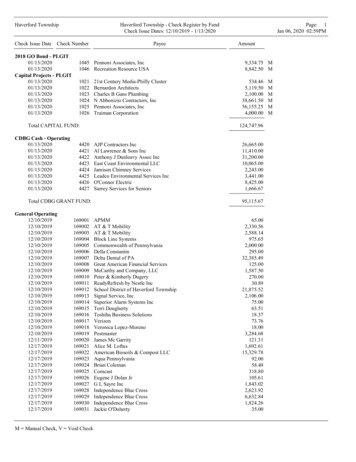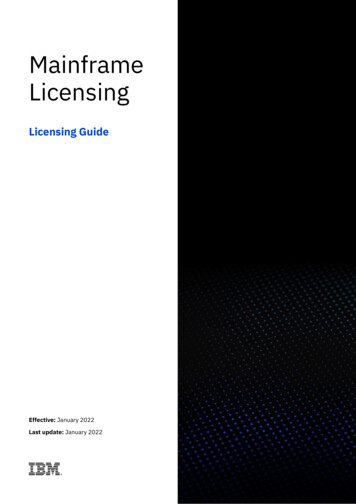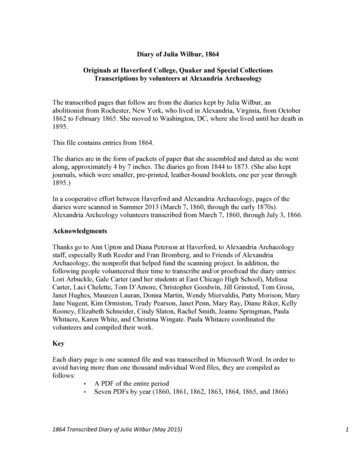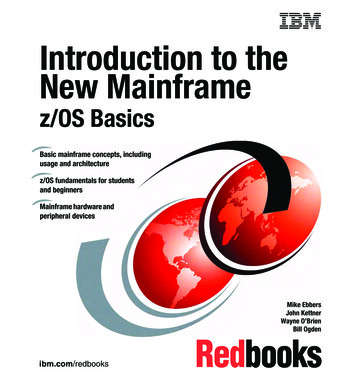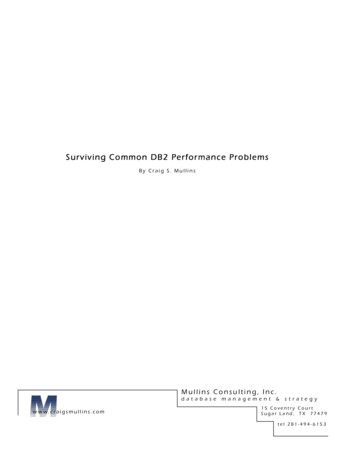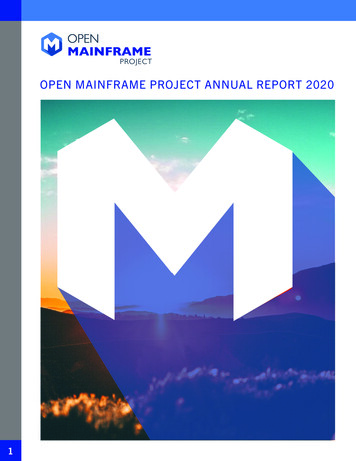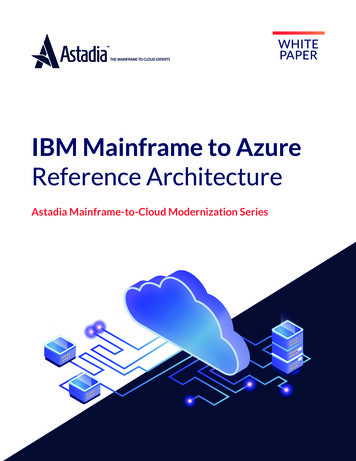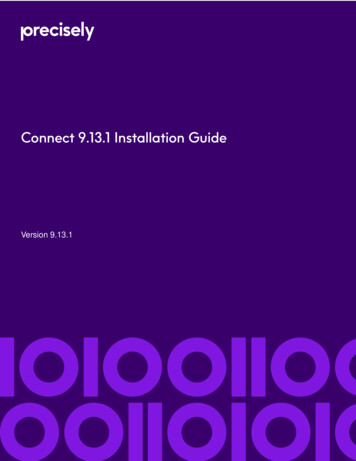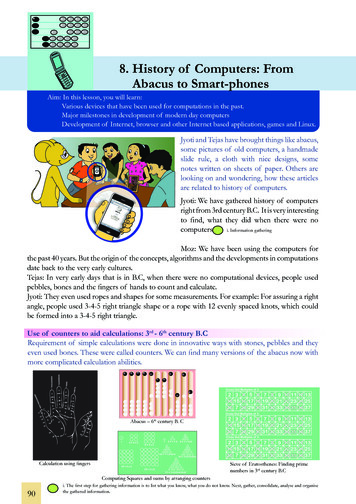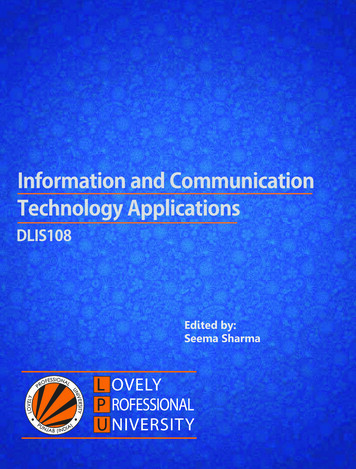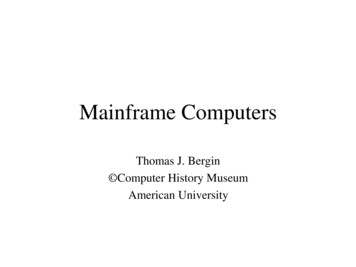
Transcription
Mainframe ComputersThomas J. Bergin Computer History MuseumAmerican University
Industry beginnings. March 1946 Eckert and Mauchly leave MooreSchool and establish the Electronic ControlCompany (ECC) December 1947 ECC re-founded as the EckertMauchly Computer Corporation (EMCC) 1948 contract with U.S. Census Bureau forUNIVAC, the UNIVersal Automatic Computer February 1950 EMCC sold to Remington-Rand March 31, 1951 1st UNIVAC delivered to Census
Electronic Control Company (ECC)
Eckert-Mauchly Computer Company 1948 Contract drawn up between EMCC andthe US Census Bureau for the production ofUNIVAC (UNIVersal Automatic Computer) September 1949 BINAC (Binary AutomaticComputer) delivered to Northrop Aviation March 31, 1951 First UNIversal AutomaticComputer (UNIVAC) delivered to US CensusBureau
EMCC Sales Brochure
John Mauchly leaning on UNIVAC
Eckert-Mauchly ComputersENIACDecimalWire10 rPrgm44 bits1 MHzMagDrum3,600490 sqftBINACBinaryStorPrgm14 bits4 MHzMagTape1,400n/aUNIVACDecimalStorPrgm6 chars2.25MHzMagTape5,400352 sqft
Remington Rand UNIVAC 43 UNIVACs were delivered to governmentand industry Memory: mercury delay lines: 1000 words of12 alphanumeric characters Secondary storage: metal oxide tape Access time: 222 microseconds (average) Instruction set: 45 operation codes Accumulators: 4 Clock: 2.25 Mhz
J. Lyons and Company Lyons tea-shops were a feature of Britishurban life in the mid-twentieth-century, apopular place to meet friends and eat snacks.Supplying the right number of cakes to theright shops on the right day was a difficultlogistical problem. Partly for this reason - andpartly because the management of Lyons &Co. were avid modernizers - the companytook a strong interest in the first experimentalcomputers.Source: www.man.ac.uk
After witnessing the Cambridge EDSAC, asophisticated machine completed in 1949,Lyons decided to build their own computerbased on the same mercury delay-linetechniques. Lyons - the tea-shop company built the first electronic stored-programcomputer for the office in 1951. They called itLEO: Lyons Electronic OfficeSource: www.man.ac.uk
EDSAC (Cambridge University)
W.D. and H.O. Willis at Bristolsource: LEO Computers Society www.leo-computers.org.uk
LEO consolesource: LEO Computers Society www.leo-computers.org.uk
J. Lyons May 1947 T.R. Thompson and O. Standingfordvisit America (Goldstine at Princeton) Nov 1947 Lyons Board authorizes aid toCambridge University May 1949 EDSAC completes 1st live job Feb 1951 LEO demonstrated to Her RoyalHighness Princess Elizabeth LEO: Lyons Electronic Office (Fall 1951)
LEO (Lyons Electronic Office) November 1951, Cadby Hall Bakery ValuationsJuly 1953, Pilot payroll for bakeries July 1954 Decision to build LEO II November 1954 LEO Computers Ltd. December 1955, Pilot Ford payroll August 1959 Army and Air Force Officerspayroll for 9000 on Hartree House Bureau(service bureau)
LEO II Installations 1 J. Lyons & Co. Ltd.London May 19572 W.D & H.O. WillsBristolSep 19583 Stewarts & LloydsCorbyJun 19584 Ford Motor Co (parts) AveleyDec 19585 Leo Computers LtdLondon Jul 19596 Ministry of PensionsNewcastle Nov 19597 British Oxygen Co.Edmonton Feb 19608 Standard Motor Co.Coventry Jul 19609. Ilford Limited (films)IlfordNov 196010 W.D. & H.O. WillsBristolApr 196111 Ford Motor Co (payroll) Dagenham Jan 1961
May 1961 LEO III available for trialsJanuary 1962 LEO III timesharing trials#1 Leo Computers Ltd Machine Bureau94 LEO III’s installed (1967-1974)1981 Post Office takes LEO 326s out of serviceafter 12-15 years of operation.
British Computer Industry February 1963 LEO Computers Ltd.merges with English Electric October 1964 English Electric purchasesLyons’ holdings; becomes English ElectricLEO Marconi March 1967 Merger with ICT to formInternational Computing Limited (ICL)
Ferranti Electric, Inc. Mark I February 1951 (U of Manchester)4000 vacuum tubes12000 resistors2500 capacitorsMemory: 256 words in electrostatic storageThe Ferranti Mark 1 was the world's firstcommercially available general-purpose computer.The first machine off the production line wasdelivered to the University in February 1951. Itwas replaced in 1958.
Manchester Mark I
Replica: Computer Conservation Societyhttp://www.computer50.org/mark1/gal3.html
Milestones February 1951 First Ferranti Mark I deliveredto Manchester University March 31, 1951 First UNIVAC delivered to USCensus Bureau Spring 1952, MANIAC and ORDVAC copies ofthe IAS machine are operational June 1952 IAS machine operational 1952 EDVAC finally finished Core memory installed on Whirlwind and ENIAC
Early IBM Machines Naval Ordnance Research Calculator (NORC)– the most powerful and effective calculator which thestate of the art would permit. Memory: 264 Williams TubesAddition: 15 microsecondsMultiplication: 31 microsecondsParts: 9000 vacuum tubes, 25000 diodesFinished: 1954 Active until 1968
IBM 650 (drum based)
IBM 650 Console
IBM 701(Defense Calculator) Addition time: 60 microseconds Multiplication: 456 microseconds Memory: 2048 (36 bit) words usingWilliams tubes Secondary memory:– Magnetic drum: 8192 words– Magnetic tape: plastic Delivered: December 1952: IBM WorldHeadquarters (total of 19 installed)
IBM 701(Defense Calculator)
IBM 701 (Defense Calculator)T.J. Watson at console; IEEE-CS timeline
Only nineteen 701s were manufactured(the machine could be rented for 15,000 per month). The first 701 wentto IBM's world headquarters in NewYork. Three went to atomic researchlaboratories. Eight went to aircraftcompanies. Three went to otherresearch facilities. Two went togovernment agencies, including the firstuse of a computer by the U.S.Department of Defense. Two went tothe Navy and the last machine went tothe U.S. Weather Bureau in early 1955.
The 701 had electrostatic storage tubememory, used magnetic tape to storeinformation, and had binary, fixedpoint, single address hardware. Thespeed of the 701 computers was limitedby the speed of its memory; theprocessing units in the machines wereabout 10 times faster than the corememory. The 701 also led to thedevelopment of the programminglanguage FORTRAN.
Expansion to market IBM 702 Commercial calculation– first delivered in 1955 IBM 704 Magnetic core memory– replacement for the IBM 701 IBM 705– first delivered in 1956 IBM 709– first delivered in 1958
UNIVAC Family Tree 1946 ENIAC1950 BINAC1951 UNIVAC1952 UNIVAC 11011960 UNIVAC 11051964 UNIVAC 11081969 UNIVAC 1106
UNIVAC I
UNIVAC 1107at Case Institute of Technology
First Generation (1951-1958) 1952 to 1957stored program: vacuum tubeslarge electronic storageintroduction of core storagebufferingrandom accessFORTRAN
Transistor William Shockley starts research onsemiconductors at Bell Labs in 1939 with theidea “that it should be possible to replacevacuum tubes with semiconductors” William Shockley, Walter Brattain, and JohnBardeen announce the transistor in 1948 ( theywin the Nobel prize in 1956)
Second Generation (1958-1964) 1958 Philco introduces the TRANSAC S-2000– first transistorized commercial machine IBM 7070, 7074 (1960), 7072(1961)1959 IBM 7090, 7040 (1961), 7094 (1962)1959 IBM 1401, 1410 (1960), 1440 (1962)ALGOL, COBOL
IBM 1401 Data Processing System
Euphemisms IBM and the BUNCH:–––––BurroughsUnivacNational Cash Register (NCR)Control Data (CDC)Honeywell Snow White and the Seven Dwarfs:– RCA (Radio Corporation of America)– General Electric (GE)
Third Generation (1964-1971) April 1964 IBM announces the System/360– solid logic technology (integrated circuits)– family of “compatible” computers 1964 Control Data delivers the CDC 6600nanosecondstelecommunicationsBASIC
IBM System/360
IBM’s Billion Dollar Gamble Model 30Model 40Model 50Model 65Model 75Model 95750 nanoseconds cycle time625 ns 19-32 mil core500 ns200 ns 13-21 mil core195 ns60 nsmagnetic film memory
CDC 6600
Source: www.scd.ucar.edu/computers/gallery/index.html
Fourth Generation (1971- ) Large scale integrated circuits (MSI, LSI)Nanoseconds and picosecondsDatabases (large)Structured languages (Pascal)Structured techniquesBusiness packages
References Maurice V. Wilkes, Memoirs of a ComputerPioneer, MIT Press, 1985 David E. Lundstrom, A Few Good Menfrom Univac, MIT Press, 1987 Charles J. Bashe, et.al, IBM’s EarlyComputers, MIT Press, 1986 Emerson Pugh, et.al., IBM’s 360 and Early370 Systems, MIT Press, 1991
References Caminer, et al, LEO, The Incredible Story ofthe World’s First Business Computer,McGraw-Hill, 1998 Lavington, Early British Computers, DigitalPress, 1980 Hendry, Innovating for Failure:Government Policy and the Early BritishComputer Industry, MIT Press, 1989.
Show and Tell Martin Weik, BRL Report No 971.UNIVAC metal tapeUNIVAC wooden models and brochuresUNIVAC modulePunched Card Data Processing Annual, 1952IBM 1401 ModelsIBM System/360 Models
Industry beginnings. March 1946 Eckert and Mauchly leave Moore School and establish the Electronic Control Company (ECC) December 1947 ECC re-founded as the Eckert Mauchly Computer Corporation (EMCC) 1948 contract with U.S. Census Bureau for UNIVAC, the UNIVersal Automatic Computer February 1950 EMCC sold to Remington-Rand March 31, 1951 1st UNIVAC delivered to Census
